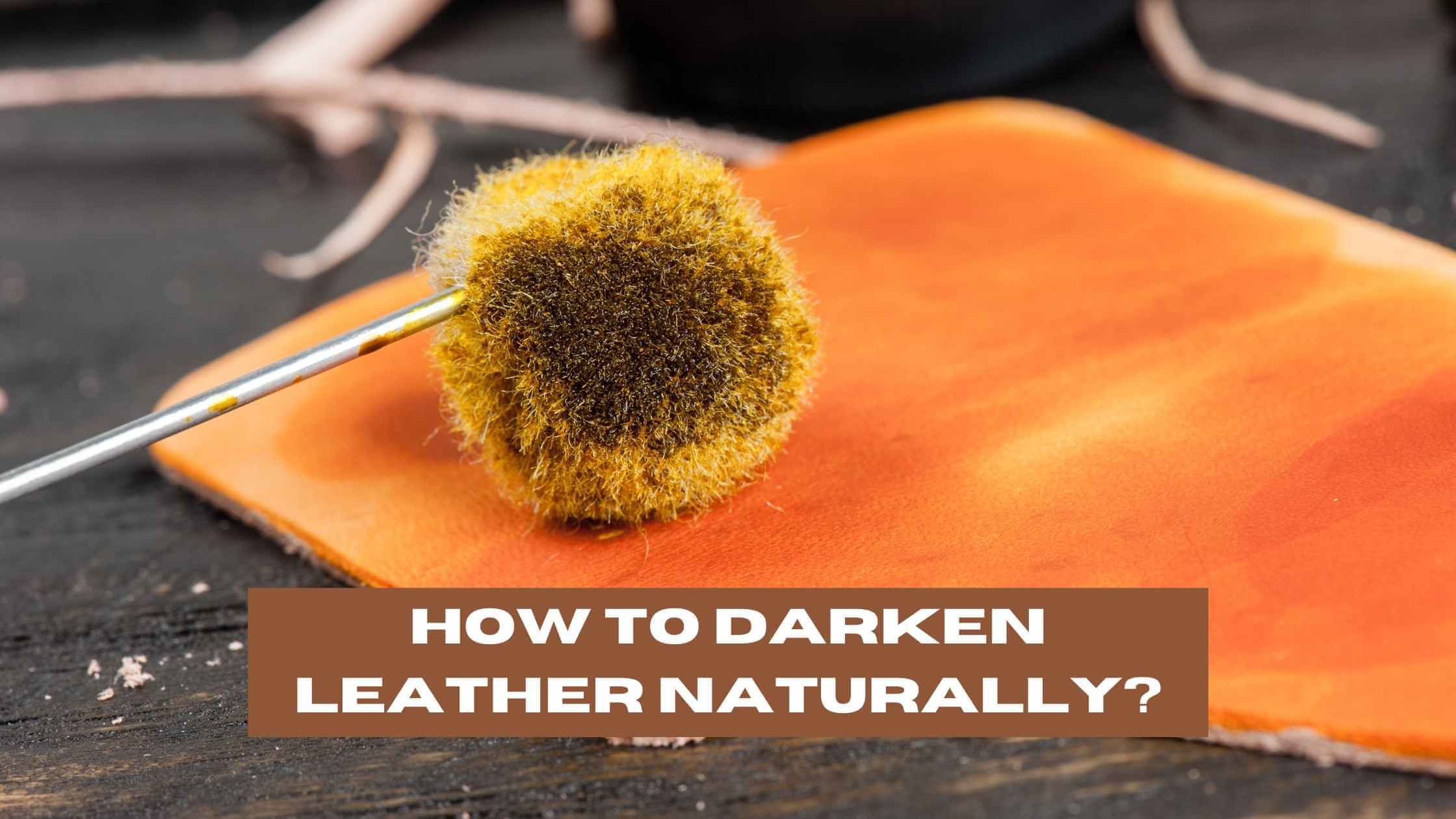Leather aficionados often seek to enhance the aesthetic and durability of their beloved items. They follow a desire for that perfectly aged, richer tone that only time seems to bestow. Darkening leather is not just about changing its appearance. It’s an opportunity to condition and give new life to a material that’s already full of character.
Whether it’s the transformation of a wallet, belt, or a pair of boots, natural methods offer a harmonious path to deepen their hue.
To darken leather naturally, you can apply natural oils such as olive, coconut, or mink oil, which condition the leather and provide a darker shade over time. Additionally, exposure to sunlight and using brewed coffee or tea can also effectively deepen the leather’s color through their natural tannins.

Preparation for Darkening
Before darkening my leather items, I ensure they are clean and that I’ve selected an optimal environment. This setup is crucial for an even and satisfactory darkening result.
Cleaning and Conditioning
I start by giving my leather goods a thorough cleaning. For this, I either use a leather cleaner or a solution of mild dish soap with water. I take the following steps:
- Wipe the leather surface with a damp cloth to remove surface dirt.
- Apply a small amount of leather cleaner or mild dish soap to a clean cloth.
- Gently clean the leather with the cloth in circular motions.
- Wipe off any excess soap with a damp cloth and allow the leather to air dry.
After cleaning, I apply a leather conditioner with a soft cloth. This step helps to maintain the leather’s moisture, preparing it for a more even absorption of the darkening agent. It’s like prepping a canvas before painting; I can’t skip it!
Choosing the Right Environment for Darkening
The right environment makes a difference in how the leather darkens naturally. I always consider these factors:
- Sunlight exposure: Sun can be an effective natural darkener due to its ultraviolet light. However, too much can cause the leather to dry and crack. I aim for a balance, often choosing indirect sunlight for gradual darkening.
- Temperature and humidity: Ideally, I’ll choose a warm place with moderate humidity. Extreme conditions can damage the leather or impact how it absorbs darkening substances.
Natural Darkening Techniques
In my experience, natural methods of darkening leather rely mainly on oils, waxes, and environmental exposure. Let’s explore how these techniques can change the hue of leather items effectively.
Using Oils and Waxes
I’ve found that natural oils such as olive oil, coconut oil, and mink oil are excellent for darkening leather. Here’s a methodical approach:
- Choose your oil: Olive oil is accessible and works well for consistent darkening. Coconut oil offers additional conditioning benefits, while mink oil provides excellent water resistance.
- Application: Apply a small amount of oil to a clean, dry cloth. Rub it into the leather in circular motions, ensuring even coverage.
- Layers: You can add more layers once the first has been absorbed for a deeper shade. Each layer should darken the leather slightly more.
Using beeswax as a natural wax can also enhance the color and add a protective layer. Here’s a concise process:
- Preparation: Rub a small amount of beeswax onto the leather surface.
- Polishing: Buff with a soft cloth to bring out a polished look, which naturally darkens the leather.
Be mindful that over-application of oils or wax can oversaturate leather, resulting in a tacky feel instead of a rich patina.
Sunlight and Air Drying
Exposure to direct sunlight and allowing leather to air dry can also darken it. The UV light from the sun contributes to this process. Here’s how I approach it:
- Placement: Position your leather item in a spot with direct sunlight. Rotate it occasionally for even exposure.
- Duration: Monitor the item frequently to observe the changing color and prevent excessive drying or fading, which can occur if left unchecked.
Remember that while sunlight can be effective, it’s a gradual process requiring patience. Additionally, prolonged exposure can harm leather, so moderation is the key.
In combining these techniques, I’ve often employed a leather dressing—a mix of oil and wax to condition and darken leather simultaneously. It’s a balanced approach that nourishes the leather while lending it a darker, richer tone.
Homemade Dyes and Stains
Experimenting with natural substances can yield fascinating results when I aim to alter the color of my leather goods. These homemade solutions often have a low environmental footprint, and can give leather a beautifully aged look without the use of harsh chemicals.
Brewed Coffee and Tea Applications
I’ve found that brewed coffee is quite effective for darkening leather, thanks to its tannins. To achieve the desired stain, I make my coffee very strong. That way, the tannins are more concentrated and the pigmentation is richer. I apply it with a microfiber cloth. Coffee can darken leather considerably, so I take care to test on a small, inconspicuous area first.
Similarly, black tea provides a subtler effect but works much like coffee. A large batch of black tea, steeped until it’s very dark, can create a gentle tint on the leather’s surface. When using tea, I verify the contents of the tea bag since some teas have added oils or flavors that might be harmful to the leather.
Creating Dyes with Natural Ingredients
For an entirely different palette of colors, natural dyes made from various ingredients such as walnut hulls can be incredibly rewarding. To create dye, I simmer the hulls in water, which extracts the pigments. This solution, once cooled, can be brushed onto the leather.
I’ve discovered that other natural products like certain tree barks or leaves contain pigments and tannins that lend themselves well to dyeing. These materials need to be processed and boiled to create leather dyes. However, it’s necessary to be aware that natural dyes can be unpredictable. Results may vary based on the original color of the leather and the concentration of the dye.
Maintaining the Darkened Finish
After darkening leather with natural methods, it’s crucial for me to take steps to maintain the new finish. Proper care and protection not only preserve the color but also ensure the leather’s longevity and character.
Regular Care and Conditioning
I understand that consistent maintenance is key in keeping my leather items looking their best. My go-to routine involves:
- Cleaning: I gently wipe the leather surface with a microfiber cloth to remove dust and dirt particles.
- Conditioning: Applying a quality leather conditioner nourishes the leather, which can prevent cracking and preserve the darkened finish. I tend to use natural oils like neatsfoot oil or coconut oil for their deep conditioning properties.
- Polishing: Occasionally, I use a matching shoe polish to add an extra layer of protection and to enhance the vintage look.
Protecting from Wear and Tear
To shield my leather items from premature wear, I adopt a few protective measures:
- Avoid Harsh Elements: I make sure to keep my leather away from excessive water and direct sunlight. They can fade and deteriorate the darkened finish.
- Use of Protectants: An eco-friendly protectant can provide an additional barrier against environmental damage.
- Proper Storage: Whenever I’m not using my leather items, I store them in a cool, dry place. This helps in maintaining their shape and color.

